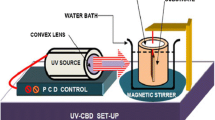Abstract
We carried out a series of experiments of metal sulfide deposition on glass and copper substrates by the successive ionic layer adsorption and reaction (SILAR) technique. This technique based on the cations adsorption process involves the presence of the van der Waals and electrostatic forces. According to the theoretical study discussed herein, the equilibrium separation between cations and the substrate surface was lower in the case of a copper substrate than that of a glass one confirming the observed experiments results obtained by the SILAR technique. The surface charge of the glass substrate is strongly dependent on the solution pH. In the absence of the surface charge, the dominant forces between cations in solution and the glass substrate were repulsive in contrast with the case of the copper substrate in which attractive forces dominate even if the surface is somewhat positively charged. This study enriches the knowledge on the optimization parameters for fabricating thin films of metal chalcogenide of good adherence.
Similar content being viewed by others
References
Hodes Gary, Chemical Solution Deposition of Semiconductor Films, NY: Marcel Dekker Inc., 2003, p. 69.
Warner, J.H., Schaffel, F., Bachmatiuk, A., and Rummeli, M., Graphene: Fundamentals and Emergent Applications, Oxford: Elsever Inc., 2012, p. 21.
Cheng, R., Shan Jiang, S., Chen, Y., Liu, Y., Weiss, N., Cheng, H.C., Wu, H., Huang, Y., and Duan, X., Fewlayer molybdenum disulfide transistors and circuits for high-speed flexible electronics, Nat. Commun., 2014, vol. 5, p. 5143.
Abderrahmane, A., Ko, P.J., Thu, T.V, Ishizawa, S., Takamura, T., and Sandhu, A., High photosensitivity few-layered MoSe2 back gated field-effect photo-transistors, Nanotechnology, 2014, vol. 25, pp. 365202-1–5.
Liu, X., Hu, J., Yue, C., Della Fera, N., Ling, Y., Mao, Z., and Wei, J., High performance field-effect transistor based on multilayer tungsten disulfide, ACS Nano., 2014, vol. 8, no. 10, pp. 10396–10402.
Anand, T. and Shariza, S., A Study on molybdenum sulphoselenide (MoSxSe2–x , 0 = x = 2) thin films: Growth from solution and its properties, Electrochim. Acta, 2012, vol. 81, pp. 64–73.
Larson, I. and Attard, P., Surface charge of silver iodide and several metal oxides. Are all surfaces Nernstian?, J. Colloid. Interface Sci., 2000, vol. 227, pp. 152–163.
Shei, S.C., Chang, S.J., and Pay-Yu Lee, P.Y., Rinsing effects on successive ionic layer adsorption and reaction method for deposition of ZnO thin films, J. Electrochem. Soc., 2011, vol. 158, no. 3, pp. H208–H213.
Kakade, B.N., Nikam, C.P., and Gosavi, S.R., Effect of immersion cycles on structural, morphology and optoelectronic properties of nanocrystalline Ag2S thin films deposited by SILAR technique, J. Appl. Phys., 2014, vol. 6, no. 6, p. 6–12.
Pathan, H.M. and Lokhande, C.D., Deposition of metal chalcogenide thin films by successive ionic layer adsorption and reaction (SILAR) method, Bull. Mater. Sci., 2004, vol. 27, pp. 85–111.
Malysheva, O., Tang, T., and Schiavone, P., Adhesion between a charged particle in an electrolyte solution and a charged substrate: Electrostatic and van der Waals interactions, J. Colloid Interface Sci., 2008, vol. 327, pp. 251–260.
Mitzi, D.B., Solution Processing of Inorganic Materials, Hoboken New Jersey: John Wiley&Sons, Inc., 2009, p. 242.
Gregory, J., Particles in Water: Properties and Processes, CRC Press, Boca Raton, Fla, 2006, p. 180.
Gao, X.D., Li, X.M., and Yu, W.D., Morphology and optical properties of amorphous ZnS films deposited by ultrasonic-assisted successive ionic layer adsorption and reaction method, Thin Solid Films, 2004, vol. 468, pp. 43–47.
Shi, Y., Jin, Z., Li, C., An, H., and Qiu, J., Effect of [Cu]/[In] ratio on properties of CuInS2 thin films prepared by successive ionic layer absorption and reaction method, Appl. Surf. Sci., 2006, vol. 252, pp. 3737–3743.
Mittal, K.L., Contact Angle, Wettability and Adhesion, Leiden, Netherlands: VSP, 2006, pp. 1–14.
van Hal, R.E.G., Eijkel, J.C.T., and Bergveld, P., A general model to describe the electrostatic potential at electrolyte oxide interfaces, Adv. Colloid Interf. Sci., 1996, vol. 69, pp. 31–62.
Rhea, R.W., HF Filter Design and Computer Simulation, Atlanta, GA: Noble, 1994, p. 78.
Chabay, R.W. and Sherwood, B.A., Matter and Interactions, John Wiley & Sons, 2015, p. 134.
Hsu, T.R., MEMS and Microsystems: Design, Manufacture, and Nanoscale Engineering, John Wiley & Sons, 2008, p. 258.
Murthy Peri, M.D. and Cetinkaya, C., Spherical nanoparticle-substrate adhesion interaction simulations utilizing molecular dynamics, J. Adhes. Sci. Technol., 2009, vol. 23, pp. 1723–1738.
Author information
Authors and Affiliations
Corresponding author
Additional information
The article is published in the original.
About this article
Cite this article
Abderrahmane, A., Kaddouri, M., Adnane, M. et al. Adsorption effect on the successive ionic layer adsorption and reaction technique. Surf. Engin. Appl.Electrochem. 51, 557–564 (2015). https://doi.org/10.3103/S1068375515060022
Received:
Accepted:
Published:
Issue Date:
DOI: https://doi.org/10.3103/S1068375515060022




